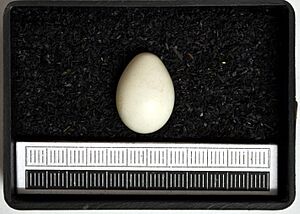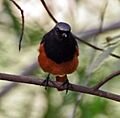Black redstart facts for kids
Quick facts for kids Black redstart |
|
|---|---|
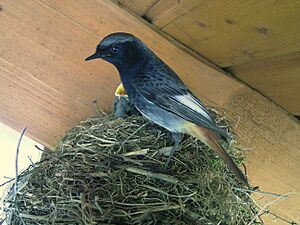 |
|
| Male subspecies Phoenicurus ochruros gibraltariensis at nest, Germany | |
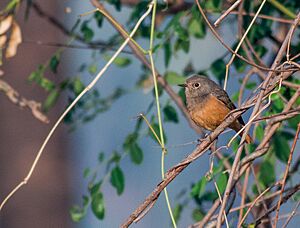 |
|
| Female, Vasai, Maharashtra, India | |
| Conservation status | |
| Scientific classification | |
| Genus: |
Phoenicurus
|
| Species: |
ochruros
|
| Subspecies | |
|
5–7, see text |
|
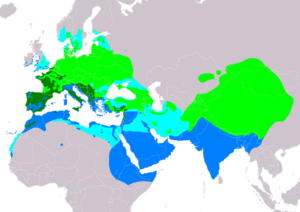 |
|
| Breeding Resident Passage Non-breeding Compiled by: BirdLife International and Handbook of the Birds of the World (2019) 2018. | |
| Synonyms | |
|
Ruticilla titys (Scop.) |
|
The black redstart (Phoenicurus ochruros) is a small passerine bird. This means it's a type of bird that perches. It belongs to the genus Phoenicurus.
Long ago, people thought this bird was part of the thrush family. But now, scientists know it's an Old World flycatcher (Muscicapidae). Some old names for it were Tithys redstart or black redtail.
Contents
Understanding Black Redstart Names
How Scientists Named the Black Redstart
The black redstart was first officially described by a German scientist, Samuel Gottlieb Gmelin, in 1774. He gave it the scientific name Mottacilla ochruros.
Later, in 1817, another scientist named Thomas Ignatius Maria Forster placed it in the genus Phoenicurus. Both parts of its scientific name come from Ancient Greek. They describe the color of its tail.
Phoenicurus means "red-tailed." The word ochruros means "pale yellow-tailed."
Black Redstart Family Tree
The black redstart is part of a group of birds found in Europe and Asia. This group also includes the Daurian redstart and Hodgson's redstart.
These birds started to become different species about 3 million years ago. They spread across much of Europe and Asia. The black redstart is not very closely related to the common redstart. Even so, these two European species can sometimes have babies together.
Different Types of Black Redstarts
There are several types of black redstarts, called subspecies. They mostly look different in the color of the adult males' undersides. Some also have different calls. Scientists usually agree on about five to seven subspecies.
These subspecies can be grouped into three main types:
- Eastern Asian Group (P. o. phoenicuroides group): These are the oldest types. Their females and young birds are light grey-brown.
- Western Asian Group (P. o. ochruros group): These types are found in western Asia. Their females and young birds are in-between in color.
- European Group (P. o. gibraltariensis group): This group lives in Europe. Their females and young birds are dark grey.
What Does a Black Redstart Look Like?
The black redstart is a small bird. It is about 13 to 14.5 centimeters (5 to 5.7 inches) long. It weighs between 12 and 20 grams (0.4 to 0.7 ounces). This is similar in size to the common redstart.
Male and Female Differences
The adult male black redstart is mostly dark grey to black on its back and chest. Its lower back and tail are orange-red. The two middle tail feathers are dark red-brown.
- Western males have a blackish-grey belly and a whitish patch on their wings.
- Eastern males have an orange-red belly and all-blackish wings.
The female black redstart is mostly grey (in western areas) or grey-brown (in eastern areas). But like the male, her lower back and tail are orange-red. She is greyer than the common redstart.
Young Black Redstarts
Young males in their first year can look different. Some look like females. Others look more like adult males but don't have the white wing patch yet. That patch only appears after their first full molt.

Where Do Black Redstarts Live?
Black Redstart Habitats
Black redstarts breed across southern and central Europe and Asia. They also live in northwest Africa. You can find them from Great Britain all the way to central China.
In warmer parts of their range, they stay all year. But birds from the northeast fly south and west for winter. They go to southern Europe, Asia, and North Africa.
Finding Black Redstarts in Cities
Originally, these birds lived on rocky ground in mountains, especially on cliffs. But since about 1900, they have started living in cities too. They like places that look like cliffs, such as buildings. They were often found in bombed areas after World War II and in large industrial areas. These places have bare ground and tall, cliff-like structures that they prefer.
How Black Redstarts Hunt
Black redstarts catch flying insects. Migrating birds often look for flies or tiny crustaceans along coastlines. They quickly duck their heads and bodies, a bit like a European robin. Their tail is often flicked. The male black redstart has a rattling song and a tick call.
Black Redstart Life and Habits
Black Redstart Breeding Habits
Black redstarts usually have one partner. They start breeding in mid-April. The female builds the nest. She usually places it in a crack or hole in a rock or wall. Sometimes, she builds it on a building ledge.
The nest is a loose cup made of grass and stems. It is lined with soft materials like hair, wool, and feathers. The female lays one egg each day. A clutch usually has 4 to 6 eggs. They are usually white, but sometimes they can be pale blue. Each egg is about 19.4 x 14.4 millimeters (0.76 x 0.57 inches) and weighs about 2.16 grams (0.076 ounces).
The female sits on the eggs to keep them warm. She starts after the last egg is laid. This takes 13 to 17 days. Both parents then feed and care for the young birds. The young birds leave the nest after 12 to 19 days.
Gallery
-
Black redstart, Phase 7, Mohali, Punjab, India



